A series of short animated films for primary schools, following the adventures of Olivia and Hassan as they're challenged with maths problems to find their way through Hypatia's mathematical maze.
Topics covered:
- Adding and subtracting using mental methods
- Adding and subtracting using written methods
- How and why we round numbers
- Using addition and subtraction in multi-step problems
- Multiplying by 10, 100 and 1000
- Mental multiplication
- Factors, multiples and primes
- Dividing using written methods
- Recognising and comparing fractions
- Adding and subtracting fractions
- Multiplying and dividing fractions
These short films are suitable for teaching maths at KS2 in England, Wales and Northern Ireland and 2nd Level in Scotland.
Primary maths teacher Kate Roscoe explains how these films can be used in the classroom to cover the ‘number’ topic for KS2 pupils, particularly upper KS2.
KATE ROSCOE:
Hi, I'm Kate Roscoe. I'm the head of maths at Holy Trinity Primary School. Like you, I'm passionate about creating and discovering the best possible maths resources for my students. That's why I loved helping create Hypatia's Mathematical Maze, a resource designed to help you deliver entertaining and educational lessons for your 9 to 11 year-olds.
Each video invites pupils to accompany two young explorers, Olivia and Hassan, on their journey of mathematical discovery, as they work their way through a mathemagical maze, solving puzzles to continue from one section to the next.
The films cover the extremely rich curriculum for Number in Key Stage Two primary maths, focusing particularly on the Upper Key Stage Two topics. Each episode tackles a separate topic. From the use of written methods to mental methods, addition, subtraction, multiplication, division and fractions, as well as working with factors multiples and primes.
HASSAN:
The number you were thinking of is 5967.
KATE ROSCOE:
The films are aimed at Upper Key Stage Two in particular, across the four nations, including working with money, experiencing numbers in the forms of different objects and abstract ideas. It will look to galvanise and excite pupils as they embark upon a new topic of work. The content is built with the mastery curriculum in mind, and is structured around fluency, reasoning and problem solving.
HYPATIA:
I am thinking of a number, I subtract 1400, I get an answer of 4567. What was my number?
KATE ROSCOE:
Each episode focuses on building fluency skills to solve a particular problem. And then poses some deeper problems to provoke discussion and reasoning. The relevant tools are given by our mathemagician Hypatia, with the help of her assistant Archimedes.
With their help, our two young explorers, Olivia and Hassan, are able to solve the problems for themselves.
HASSAN:
Any ideas?
OLIVIA:
The sum of two numbers is 2309.The difference between these numbers is 129. What are the numbers? Hmm.
ARCHIMEDES:
Try drawing it out.
KATE ROSCOE:
You may wish to play the episode up to the point at which a problem is being solved and then pause to that point so you can have a discussion with your class about the strategy they might use to solve it.That way they can share in our characters' sense of achievement at having found out the right answer.
OLIVIA:
Woo! Yes!
KATE ROSCOE:
These videos are designed to be the building blocks which you might use to introduce a topic or unit of work. Using the film as aspringboard, you could integrate the mathematical maze story into your lessons by setting a series of reasoning and problem solving challenges based upon the topic, so that your pupils can progress through the sections of a labyrinth and emerge victorious at the end.
The characters in these films also embody a sense of real determination and persistence. Olivia and Hassan don't always immediately get the answer right, but learn to recognize and correct their own mistakes.
OLIVIA:
Let's do this, Hassan!
KATE ROSCOE:
Teaching through good mistakes can be a really good starting point, as building in a useful stumbling block can help to build reasoning into a lesson. This is a skill you can encourage in your own classes by allowing pupils to share in their learning and solve their mistakes. Importantly, these films are designed to inspire mathematical talk, so that pupils have the vocabulary to reason about maths and discuss what an answer could be or can't be.
ARCHIMEDES:
No worries, no one gets to be a great mathemagician without making mistakes. What?
KATE ROSCOE:
These films are designed to be standalone or watchable together. At the end of each film, there is a question which goesslightly deeper into the topic, which can serve as a springboard into class discussion and independent learning or group work.
OLIVIA:
It's working! We're going through to the next staaage!
KATE ROSCOE
I really hope you find these new BBC Teach resources useful and that they help you to not only deliver the content of the curriculum, but also to inject a bit of adventure and fun into your maths lessons.
Adding and subtracting using mental methods. video
In a mythical temple full of obstacles, Olivia and Hassan learn simple mental maths and apply it to work out the passcode to open the door.
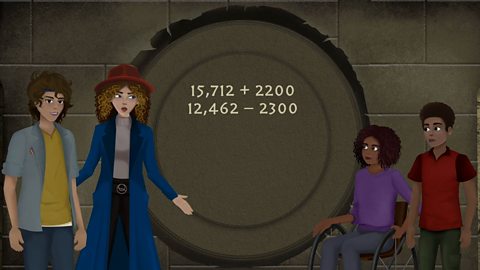
Adding and subtracting using written methods. video
Having been transported to a floating library, Olivia and Hassan's ability to solve large equations using written methods is tested.
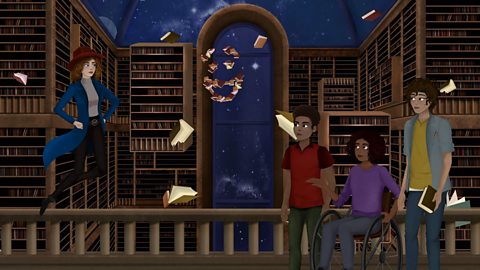
How and why we round numbers. video
Olivia and Hassan are taught how to round to the nearest 1000, 10,000, and 100,000 when a disgruntled magic carpet demands money from them.
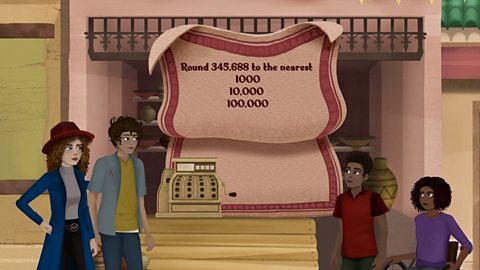
Using addition and subtraction in multi-step problems. video
Inside a giant computer created before the age of mathemagicians, Olivia and Hassan are faced with a multi-step problem to reach the labyrinth’s next stage.
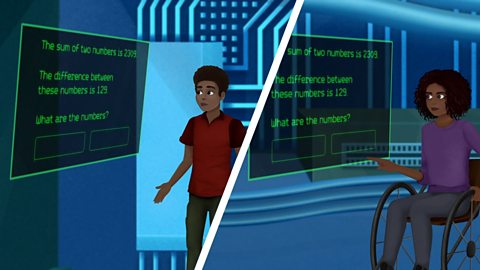
Multiplying by 10, 100 and 1000. video
When Olivia and Hassan find themselves on the roof of an enormous skyscraper they learn how to multiply by 10, 100 and 1000 and work out the number of windows on the building.
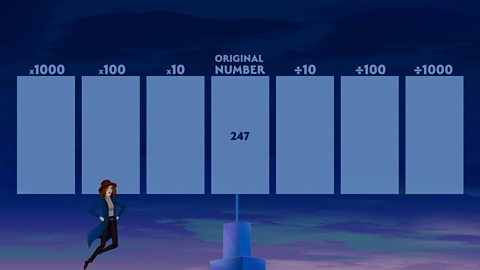
Mental multiplication. video
While exploring a jungle, Olivia and Hassan learn the true nature of square numbers as being created when two of the same number are multiplied together.
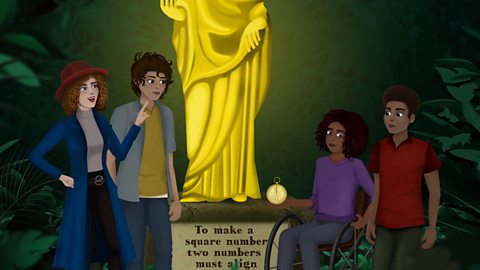
Factors, multiples and primes. video
Trapped in a desert together with Archimedes, Olivia and Hassan learn what common factors, multiples, and prime numbers are.
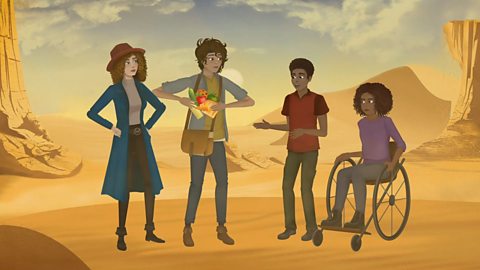
Multiplying using written methods. video
Finding themselves in space, Olivia and Hassan watch mathemagician Hypatia perform long multiplications in the sky by bending the stars.
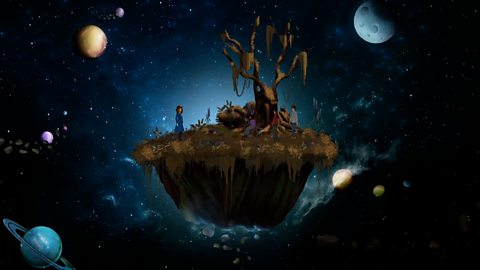
Dividing using written methods. video
Olivia and Hassan learn how to perform long division in order to free gridlocked traffic on a bridge.

Recognising and comparing fractions. video
Olivia and Hassan are enjoying themselves in a world made out of pizza and learn how to work with numerators and denominators in fractions.
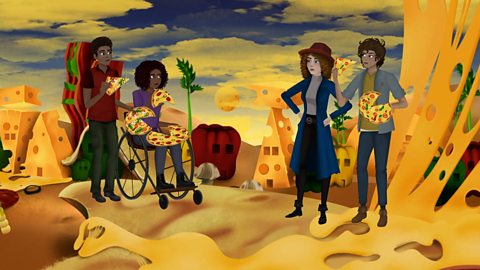
Adding and subtracting fractions. video
Amongst the ruins of an ancient city, Olivia and Hassan learn how to add and subtract fractions.
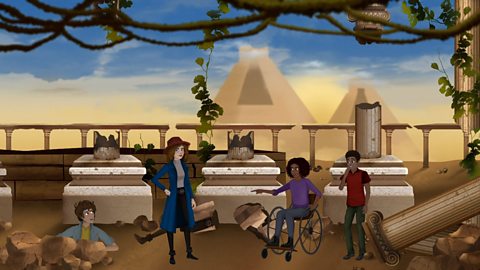
Multiplying and dividing fractions. video
In a mysterious crystal cave, Olivia and Hassan get to work dividing and multiplying fractions in order to find their way out.
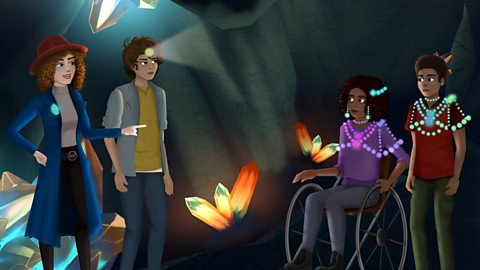
Where next?
Super Movers: KS2 Maths
All our KS2 Super Movers maths videos in one place. Find fun, curriculum-linked resources to get your class moving while they learn, featuring Naomi Wilkinson, Hacker T. Dog and the Worst Witch.
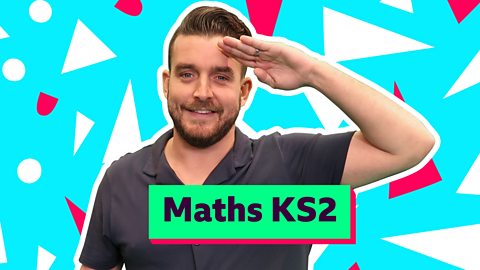
Bitesize
Use these Bitesize resources to set homework, independent study tasks or to consolidate learning for your pupils.

Newsround
The latest news stories from Newsround to share in the classroom.
